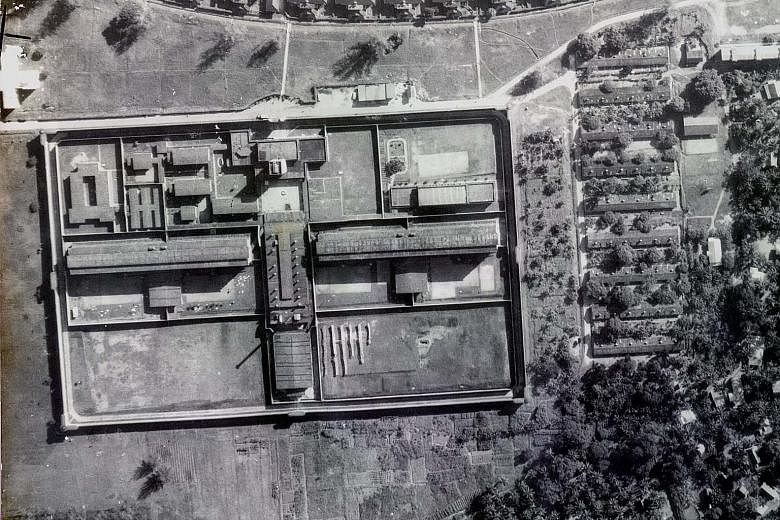Shudders would go down teenager Vilma Stubb's spine when the thumping of the boots of Japanese sentries reverberated through the hallways at night.
With their blinding torchlights, the sentries taunted the wartime internees in their Changi Prison cells.
Until then, the Canadian citizen had been like any other girl.
Born in Singapore, Vilma attended Raffles Girls' School until the Japanese invaded Singapore in 1942.
Desperately, her family packed their bags and planned to leave Singapore. But the ship that promised to take them to safety was bombed and captured at sea.
They were first taken to Sumatra to be interned, and then moved to Changi Prison.
"We were given an open floor space to which we had no privacy. There were no walls to contain our voices, so speech had to be low or hushed," Vilma, now 88 and known as Mrs Howe, told The Straits Times in an e-mail interview from Canada.
Till today, Changi Prison's walls and entrance remain a chilling sight to the Canadian whenever she visits Singapore. She was last here in 2015 for the 70th anniversary of the end of World War II, and again in February this year for the 75th anniversary of the fall of Singapore.
A solemn atmosphere still hangs over the 81-year-old facility, now a civilian prison.
Parts of it were gazetted as a national monument on Feb 15 last year: the imposing 180m stretch of wall, along with its double-leafed steel entrance gate and two corner turrets, which stand as historical symbols whose significance extends beyond Singapore.
Internees of various nationalities, including British, Australian and Dutch, were subjected to harsh living conditions rampant with diseases such as malaria and beriberi during the Japanese Occupation.
The prison, completed in 1936 by the British when Singapore was still under colonial rule, was constructed to alleviate overcrowding, which was only temporarily resolved with the completion of the Pearl's Hill Criminal Prison, later known as Outram Road Prison.
Changi Prison was then designed as a maximum-security facility with modern equipment such as a comprehensive alarm system and electrical lights in its cells.
It was built to house convicts but all that changed when the Japanese invaded Singapore and Britain formally surrendered on Feb 15, 1942.
The prison became a facility to house civilian internees, including women and children, and was part of the prisoner-of-war (POW) camp that occupied the whole Changi area.
After the war, it was the venue for several military courts, and those convicted of war crimes were hanged there. It returned to civilian control only on Oct 15, 1947, two years after the end of World War II.
Besides its rich history, the prison's architectural design also made it unique: It was laid out in the outline of a telephone pole.
According to Associate Professor Anoma Pieris of the Melbourne School of Design, who is part of a current Australian Research Council fellowship project on the Pacific War, the layout consists of parallel wings and a central corridor, a design that was first used in the late 19th century in Britain and France.
The turrets, located in the four corners of the compound, served as watch towers. Two have been preserved.
In 2003, Australian politicians lobbied for the preservation of the prison after learning about Singapore's plans to replace the facility with a $1-billion prison complex.
In March of the following year, the Singaporean authorities decided to preserve certain key features of the complex while keeping to plans for the new Changi Prison Complex.
Historian Brian Farrell, the head of the department of history at the National University of Singapore, said in a phone interview: "The fact that Changi Prison was used as an internment camp for POWs and civilians during World War II makes it an iconic prison and an emotionally important historical site."
The prison was designed to house up to 600 criminals, but some 76,000 Allied soldiers and civilians were marched to the east of Singapore and interned at the prison and nearby barracks.
Time seemed to wear on without the hope of freedom for Mrs Howe when she was an internee.
While she spent 3 1/2 years in internment, having been taken in when she was around 15 years old, her days in Changi impacted her far longer than that. "While I was an internee, there were many instances when I was depressed and wondered if I would ever be free to live out my adolescent life."
However, life after liberation was also no bed of roses at the start.
"The first few years of readjustment after liberation were extremely difficult, and it took a toll on my family as we did not adjust well to post-war living, having no possessions to begin with," she said.
Mrs Howe's family emigrated to England shortly after the war. She eventually settled in Canada, which has been her home for over 60 years.
It was only after the war that she found out that her uncle, Mr Claude Armstrong, who was Singapore's harbour master when the war first broke out, was captured by Japanese forces during the Double 10th Incident.
During the incident, the Japanese military police raided cells to ferret out POWs who were suspected of being involved in the destruction of Japanese ships in a previous operation. Mr Armstrong was one of the 15 men who were tortured and died as a result.
Despite the scarring experience Mrs Howe had in Changi Prison, she maintains that it is important for people to be aware of those tumultuous years.
"While the image of Changi remains a sight that I shudder at, I am, at the same time, curious to see more of it," she said.


